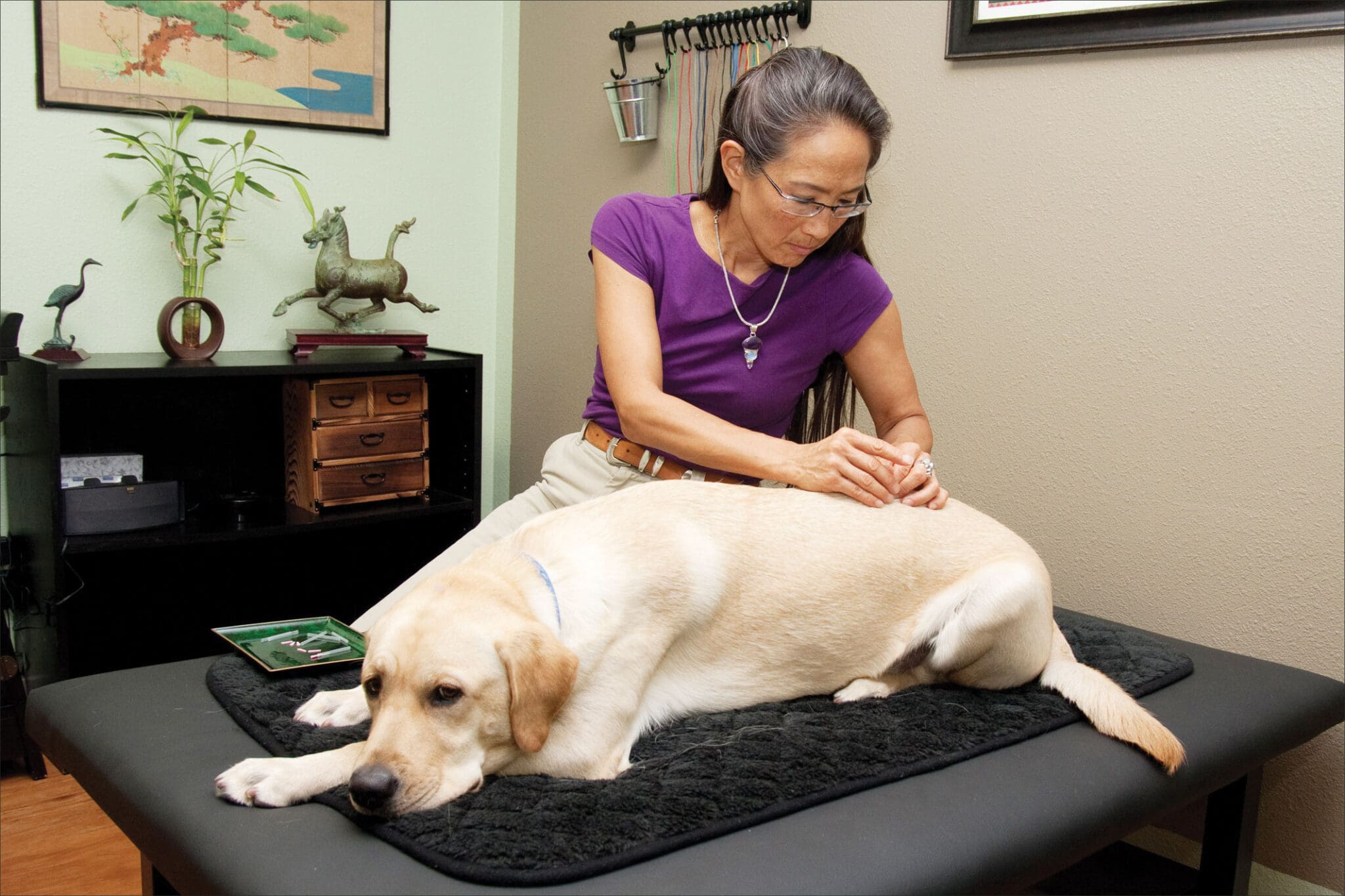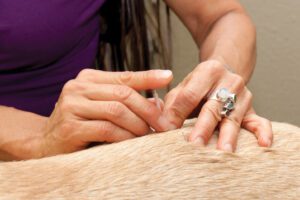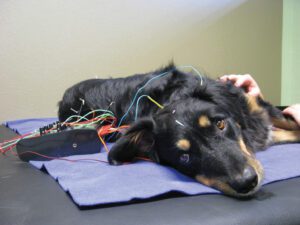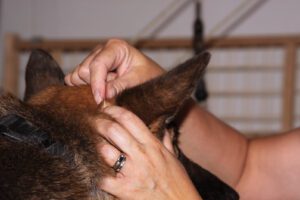Cornelia Guest doesn’t have a veterinary degree, but she does have decades of experience caring for animals. The renowned New York socialite, author, philanthropist, and businesswoman, the creative force behind a very successful line of designer vegan handbags, grew up riding horses and has always had a number of canine companions (she currently has nine!).

Guest has always had a passion for both animals and natural healthcare. She chooses natural healing modalities over Western pharmaceutical intervention whenever possible – for herself and her dogs. Guest entrusts the care of her nine dogs to Babette Gladstein, VMD, owner of
Animalacupuncture.net in New York, New York. Dr. Gladstein says she has treated Guest’s dogs for a variety of health conditions, including growing pains in her young Newfoundland, Cash; bladder stones in her German Shepherd Dog, Belinda; and arthritis in her 18-year-old West Highland Terrier, Arthur.
“I’ve tried many different veterinary modalities for my dogs, and acupuncture has been by far the most effective,” Guest says. “I’ve never seen the magic that happens with Chinese medicine – especially acupuncture – occur with conventional veterinary care.”
Guest is not alone in her endorsement of this ancient healing practice. The American Veterinary Medical Association’s (AVMA) House of Delegates approved veterinary acupuncture as an alternative and complementary modality in 1996, stating that it is an “integral part of veterinary medicine.” Its popularity among both pet owners and veterinarians has steadily increased.
“The increased demand for veterinary acupuncture mirrors its rise in popularity among humans,” says Deborah Prevratil, executive director of the International Veterinary Acupuncture Society (IVAS), which offers advanced acupuncture certification for veterinarians. IVAS has trained more than 6,000 veterinarians worldwide in animal acupuncture since its inception in 1974, and Prevratil says its membership has grown steadily in the past decade, with about 1,800 veterinary members today.

Simon Flynn, executive director of the American Academy of Veterinary Acupuncture (AAVA), IVAS’s United States affiliate, also reports a growth in membership within the past decade. Flynn says that in 2012, the AAVA’s membership consisted of approximately 940 veterinary acupuncturists, compared with about 680 members in 2002.
“Many people view their pets as part of the family and want them to derive the same benefits from acupuncture that they’re experiencing with their own health, which is helping to drive this growth,” Flynn says.
Brian Husbands, DVM, a board certified veterinary oncologist (DACVIM) and certified veterinary acupuncturist (CVA) with BluePearl Veterinary Partners in Minneapolis, Minnesota, has seen similar rates of growth in his practice. “As a scientist, I did a lot of research before deciding to become certified in veterinary acupuncture,” Dr. Husbands says. “I’m glad I did, because my patients are benefitting tremendously.”
A BRIEF HISTORY OF ACUPUNCTURE
Acupuncture is one of the oldest recorded forms of healing. “Acupuncture” literally means to “puncture with a needle.” Acupuncturists insert very fine, solid needles made of stainless steel (some may be gold plated, or have handles that are wrapped with copper wire) into the skin at specific points on the body, to stimulate and create a physiological change.
In traditional acupuncture, only needles are used to stimulate the acupuncture points. Today, many practitioners also use electroacupuncture, wherein needles are inserted in the patient’s body in the usual way, and then attached by light wires to a machine that generates tiny electrical pulses. The frequency and intensity of the impulse delivered is adjusted depending on the condition being treated. Among the advantages of electroacupuncture are increased effectiveness of treatment and potentially fewer treatments required. Obviously, this is a modern innovation!
Acupuncture was developed thousands of years ago in China as a component of Traditional Chinese Medicine (TCM), which also involves natural healing practices such as herbal therapies and nutritional (food) therapy. The Nei Jing, the seminal Chinese textbook on TCM, which contains 81 chapters on acupuncture, was compiled between about 305 and 204 BC, but it wasn’t until more than 2,000 years later that acupuncture made its way West.
Acupuncture gained a serious boost of credibility in the U.S. when it became the topic of the National Institutes of Health (NIH) Consensus Development Program. Initiated in 1977, the goal of the Consensus Development Program is “to consolidate, solidify, and broadly disseminate strong evidence-based recommendations for provider practice.” Consensus Development Conferences are developed when there is a strong body of evidence about the topic, but the information has not been translated into widespread clinical practice.
In November 1997, the 12-member review panel and 25 additional experts from a number of medical fields, presented scientific data on acupuncture’s efficacy to a conference audience of 1,200. According to the panel:
“Findings from basic research have begun to elucidate the mechanisms of action of acupuncture, including the release of opioids and other peptides in the central nervous system and the periphery and changes in neuroendocrine function. Although much needs to be accomplished, the emergence of plausible mechanisms for the therapeutic effects of acupuncture is encouraging.”
Based on its findings, the panel concluded that:
“There is sufficient evidence of acupuncture’s value to expand its use into conventional medicine and to encourage further studies of its physiology and clinical value.”
Acupuncture’s mode of action differs depending on whether you’re speaking with a practitioner trained in traditional Chinese medicine or a Western allopathic physician. The results, however, are the same.

According to the principles of TCM, all living beings are imbued with a vital universal energy, called “chi” (sometimes spelled “qi” but in any event pronounced “chee”). Chi flows in a precise manner along a network of channels, or meridians, that run deep within the body and connect to the major organs and systems. Meridians are mapped, however they do not exist in the physical sense, like the circulatory or nervous systems. Meridians are an invisible, energetic network that transports chi to every part of the body.
Dogs have 12 regular meridians, which run parallel in pairs along opposite sides of the body and connect to specific organs:
– Lung
– Large Intestine
– Stomach
– Spleen
– Heart
– Small Intestine
– Bladder
– Kidney
– Pericardium
– Triple Heater/San Jiao
– Gall Bladder
– Liver
They also have two special meridians, the Conception Vessel and the Governing Vessel, which are unpaired single meridians that do not connect to specific organs.
The Conception Vessel receives and regulates all the chi of the yin (soft, relaxed, feminine) energy meridians. It begins internally, with its first exterior point beneath the dog’s anus, and runs along the ventral midline of the dog’s body (closest to the abdomen), ending at a point on the lower lip. This vessel is important to all reproductive functions.
The Governing Vessel also begins near the base of the tail and runs the length of the dog’s body along the dorsal midline (closest to the back), ending at a point between the upper lip and gums. The Governing Vessel receives and regulates the chi of the yang (fiery, solid, masculine) meridians.
Each point on each meridian corresponds to a specific function. Points are labeled according to a numerical system in order to identify their exact location. GV 14, for example, represents the fourteenth point along the Governing Vessel, while LI 7 represents the seventh point on the Large Intestine. “This numerical shorthand enables practitioners to quickly and easily identify the points they have treated,” says Sandi Leonard, DVM, owner of Veterinary Alternatives in Kansas City, Missouri.
Although the regular meridians share names associated with Western-based organs, their function does not necessarily coincide with, and is not limited to, that organ. The spleen, for example, serves as an immune organ in Western medicine, but in acupuncture it is associated with transporting matter (such as food and drink) through the body, transforming it into chi, and moving that chi around the body as needed. “The connection between meridians and anatomical systems is complex, and acupuncture specialists trained in TCM spend many hours learning about these relationships,” Dr. Husbands says.
As chi flows along the meridians, its energy nourishes every cell in the body. “To maintain optimum health, chi must be able to flow freely. When chi becomes unbalanced or blocked, illness results,” Dr. Leonard says.
Acupuncture points are specific spots where the meridians surface just under the skin. By inserting needles into these points, practitioners can manipulate chi and unblock or rebalance it, stimulating the body to heal itself.
Western Interpretation
While Western medicine does not acknowledge the presence of chi or meridians, numerous scientific studies verify acupuncture’s benefits, including:
– Reducing inflammation. “Acupuncture increases blood flow, which stimulates blood cells that fight inflammation,” says Dr. Leonard.
– Creating a sense of well being by increasing circulating levels of serotonin and endorphins, neurotransmitters responsible for altering mood and brain chemistry. “These ‘feel-good’ chemicals are responsible for a wide range of positive emotions, including relaxation, happiness and even euphoria, while low levels are associated with sadness and depression,” Dr. Gladstein says.
– Reducing pain. The endorphins and serotonin produced during acupuncture also inhibit pain responses in the brain, while increased blood flow releases nitric oxide (NO), a chemical compound recognized for its analgesic (pain-relieving) and anti-inflammatory properties.
– Stimulating and enhancing the immune system, with measurable effects, such as improvements in leukocyte counts, and enhancement of leukocyte phagocytosis.
– Alleviating nausea. “Acupuncture supplies energy to nerves that affect the gastrointestinal tract, which in turn promotes good GI function,” says Dr. Husbands.
– Veins, arteries, and nerves are bundled together throughout the body, explains Dr. Gladstein. When you excite specific acupuncture points with needling, you accelerate their electrical conductivity, which increases blood flow and releases chemicals that promote healing.
Best Applications For Acupuncture
There are acupuncture points to treat just about any condition, from reviving a dog in shock to stimulating cranial nerves that enhance appetite.
Acupuncture is most commonly used to treat:
– Muscle strains, sprains, ligament/tendon inflammation/tears
– Behavioral disorders
– Allergies
– Dry eye
– Gastrointestinal issues such as IBD, vomiting, or diarrhea
– Muskuloskeletal diseases such as arthritis, back problems, and hip dysplasia
– Nausea related to chemotherapy
– Neurologic conditions
– Reproductive issues
– Respiratory conditions
– Skin issues
– Stress
– Urinary conditions
In his oncology practice, Dr. Husbands uses acupuncture to improve the quality of life of patients undergoing chemotherapy. “Acupuncture is extremely effective at reducing nausea and vomiting related to chemotherapy, and to stimulate the appetite. So, while it may not cure the cancer, it can certainly make the dog’s life a lot more comfortable.”
Acupuncture can sometimes work in cases where Western medicine has thrown in the towel.
In 2006, Dr. Leonard used acupuncture to dramatically alter the fate of a German Shepherd Dog named Piper. At just 21/2 years old, Piper was an agility and herding dog with a bright competitive future ahead of her. But then she began having grand mal seizures. “It was very frightening and traumatic in the beginning. There was no history of seizures in her blood line or rhyme or reason for it,” says Steve Grace, Piper’s owner. He and his wife took Piper to conventional veterinarians, who diagnosed her with epilepsy.
The veterinarians prescribed phenobarbital and potassium bromide, but even on the medications, Piper continued to suffer from violent cluster seizures about every 10 days. “A veterinary neurologist told us that if we got the seizures down to three weeks apart, it would be a miracle,” Grace says. “Dr. Leonard was treating our dog Keiko for arthritis at the time, so we decided to have her try acupuncture on Piper. It was so bad that we were considering putting Piper down, so we figured we had nothing to lose.”
Dr. Leonard’s initial protocol began with twice-weekly treatments. Within a few weeks, Grace says the severity of Piper’s seizures decreased from a 9.5 to a 4 or 5 on a scale of 10, and the frequency reduced to once per month.
After a year and a half, Piper’s seizures decreased to a severity of about 3 and occurred approximately once every 45 days. The treatments were scaled back to every two weeks, and Piper remained on her medication. “The longer Piper was treated, the less intense the seizures became and the more time that passed in between,” Grace says. After a couple of years of acupuncture, Piper’s seizures decreased to once every 6 months, then once per year.
Piper recently passed away from cancer at age 11. She had not suffered from a seizure in more than two years.
Consult with a veterinary acupuncturist to determine if treatment is right for your dog, advises Dr. Gladstein. “Acupuncture is not a ‘one-size-fits-all’ modality. It is completely unique to the individual. Only after a thorough examination by a trained veterinarian can you determine if the treatment plan, cost and expected results are right for you and your dog.”

An immediate call might be warranted if your dog:
– Battles emotional issues such as fear or anxiety
– Experiences nausea related to chemotherapy
– Has a sudden-onset problem such as a muscle injury or acute nausea
– Needs a general boost to his immune system
– Suffers from side effects of a chronic illness, such as vomiting or diarrhea
– Takes long-term medications to treat inflammatory conditions such as chronic arthritis or gastrointestinal issues. “Acupuncture can help minimize or in some cases eliminate the need for prescription drugs and greatly improve the quality of life for these dogs,” says Dr. Leonard.
Contraindications
When shouldn’t a dog receive acupuncture? While acupuncture is considered one of the safest healing modalities for people and animals, there are a few instances in which it should be avoided or used with extreme caution:
– Bleeding disorders. “Acupuncture needles are inserted only superficially, however there still is a chance of bleeding or bruising, which is accentuated in dogs with bleeding disorders,” advises Dr. Leonard.
– Cancerous tumors. Since acupuncture improves blood flow, needling through or around a tumor could provide it with energy it needs to grow. “You can still do acupuncture on the patient as long as you stay far from the tumor,” says Dr. Husbands.
– Pregnant animals. Caution should be used to avoid stimulating premature labor.
– Skin infections. Needling an infected area could spread the infection.
Selecting a Practitioner
Deborah Prevratil of IVAS advises selecting a practitioner who has been certified by, or at least completed training through, one of the three main certifying organizations: the Chi Institute, IVAS, or the Medical Acupuncture for Veterinarians (MAV) program offered by the Colorado Veterinary Medical Association (see “Resources,” right).
Veterinarians trained by IVAS undergo 160 or more hours of acupuncture study and must pass written and practical exams, Prevratil says. “This training ensures the practitioner possesses a sound understanding of acupuncture principles, acupuncture points, and diagnostic techniques.”
Dr. Husbands points out that when practiced by a trained veterinary acupuncturist, the complication rate is very low, about 0.5 percent.
“Several papers in human medicine indicate that the only complications associated with acupuncture arise from unskilled practitioners,” he says. “This is the same with veterinary medicine, which is why it’s so important to choose someone who has taken the time to obtain specialized training.” He warns against allowing any non-veterinarian to practice acupuncture on an animal, regardless of state laws. “Even when practicing complementary medicine, you need to have a deep understanding of animal physiology so you can diagnose and treat the pet holistically.”
What can you expect?
Most dogs tolerate acupuncture well. “These are very tiny needles, so most of the time the dog doesn’t even notice when they’re inserted,” Dr. Leonard says. Dogs often relax and might even fall asleep during the treatment; however, some dogs will fidget, especially during the initial visit when they are unsure of what’s happening.
Veterinarians typically insert multiple needles into various acupuncture points. The number of needles, specific points treated, and duration of the treatment depend upon the individual dog and the condition being treated. Husbands says his average patient receives between 8 and 20 needles per visit, which remain in between 5 and 20 minutes.
Since relaxation is essential, the veterinary clinic may provide a special acupuncture room designed to promote a sense of calm – for both the animal and owner. BluePearl’s acupuncture treatment room includes carpeting, a couch, and cocktail lights that dim to create a soothing glow. Owners remain with their dog during treatment and are instructed to keep their dog sitting or lying. “We give them a bell to ring in case they need assistance,” Husbands says. “So far, no one has rung the bell.”
Other veterinary acupuncturists, such as Drs. Gladstein and Leonard, create the ultimate relaxation experience with in-home visits.
The most common side effect of acupuncture is relaxation. Some dogs experience temporary minor soreness from the needles, which Dr. Gladstein says subsides quickly. Risk of infection is extremely low, since sterile disposable needles are used.
Animals with acute issues, such as an injury or sudden nausea, typically require fewer treatments than those with chronic conditions. “Dogs who have rather sudden onset of a problem tend to respond really quickly and readily to acupuncture,” says Dr. Husbands. “Patients with problems that have been going on weeks to months will still benefit, but it might take longer.”
Treatment plans vary depending upon the individual dog and the condition being treated. Expect to begin with weekly or bi-weekly treatments that will taper down to a less frequent maintenance level as the dog improves. Older animals typically require more frequent treatments because their bodies break down endorphins – essential in fighting pain – more quickly than younger dogs.
Conventional medicine often condemns acupuncture as providing little more than a placebo effect, but Leonard points out that such criticism does not apply with animals, since animals don’t “know” they are supposed to feel better. “My first acupuncture patient was a 200-pound Mastiff who couldn’t walk due to a lame leg,” she says. “After about three months of treatment she was effortlessly walking up stairs, and you couldn’t tell which was the bad leg. This dog certainly didn’t ‘think’ herself better.”
Dr. Gladstein agrees. “If you understand neurology and how the various aspects of the body interrelate and ‘communicate,’ acupuncture makes perfect sense. Even thousands of years ago, the Chinese had it together.”






I never knew that acupuncture is one of the oldest recorded forms of healing. I should take my dog sometimes for this acupuncture and also I’m interested to try it. Thank you for the information about animal acupuncture.